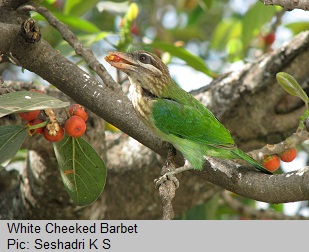Any and all opinions expressed in
this newsletter are solely those of the author(s) and do not reflect the opinion of ATREE.
Centre for Excellence
in Conservation Science
Royal Enclave,Srirampura,Jakkur
Post
Bangalore-560064
Telephone: 080-23635555 (EPABX)
Fax : 080- 23530070
Ficus
and culturally important trees in any
landscape. They are sacred and always
associated with some deity or the other.
This makes it a common tree in human
dominated landscapes and people have
planted and protected several species of
ficus for generations. The fruits of ficus,
called figs are eaten by a variety of birds
and mammals. The unique character of figs
is its asynchrony in fruiting that allows a few
trees to be in fruit all through the year. This
means figs are a reliable resource and
many species can depend on it for survival.
It's so attractive that one of our interns Mr.
Trevor who did a study on fig trees near
Singampatti village found that some species
of frugivorous birds and bats will visit large fig
trees even when there is high human
disturbance around them, say in a busy
temple or in a busy city. Another interesting
thing that the study showed was tree seedling
or fig trees are ecologically
density is significantly higher under these
sacred trees compared to in the open area
which implies that birds and mammals bring
lots of seeds of other tree species and deposit
under the fig tree allowing regeneration of a
diversity of trees in the landscape. This way
the animals are the real tree planters and
what they need is some protection, for both
the dispensers and the seedlings they
disperse. Some of the oldest fig trees are found in temples or along road sides. In
both these places these trees are under
threat; temples grow to accommodate
more people and roads to accommodate
more cars, so the big fig tree is either
pruned or simply cut. Many of the roads in
the Tirunelveli districts were once lined with
large fig trees but these have been cut to
widen the roads. Would all figs meet the
same fate? On a recent visit to the district
and indulging in my favourite pass time of
looking out of the train or bus window and
dreaming of the landscape, I noticed that
all the small shrines of Sodalaimadan and
others had ficus trees and most of them were
young may be 5-6 years old. This gave me
hope that the future generation will not only
see ficus trees but also the birds and bats that
visit them to eat the fruits and continue to be
natures gifted tree planters.
Editorial
Team
Editor: Allwin
Jesudasan
Associate editor: Rajkamal
Goswami
Editorial Review: R.
Ganesan, M. Soubadra Devy, T. Ganesh
Design and presentation:
Kiran Salagame
A S H O K A T R U S T F
O R R E S E A R C H I N E C O L O G Y A N
D T H E E
N V I R O N M E N T
Tree planters of a different kind
- T Ganesh
If you have any suggestions or comments
please let us know through the boxes below






